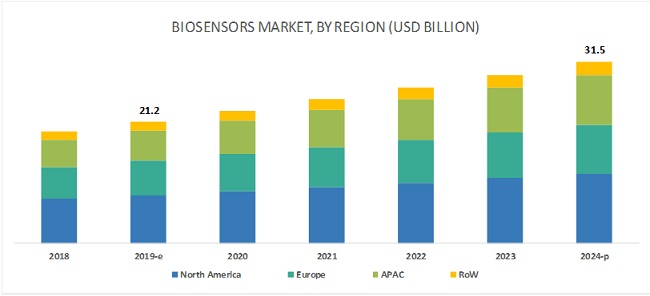The overall biosensors market size is expected to grow from USD 21.2 billion in 2019 to USD 31.5 billion by 2024, at a CAGR of 8.3%.as per a report by MarketsandMarkets.
Significant technological advancements in last few years
Significant efforts have been made since the last few years for advancing biosensors technology and its applications. For instance, the multianalyte determination for environmental monitoring and screening is among the advancements that have been witnessed in the biosensors ecosystem. Miniaturization has helped develop small, compact, easy-to-handle biosensors, which have changed the conventional testing scenario in medical and healthcare sectors. A few examples include compact blood glucose monitoring systems, cholesterol testing systems, and pregnancy testing systems. PoC diagnostics—another technological advancement—contribute to the overall demand for biosensors.
Players in the PoC diagnostics market are increasingly focusing on technological advancements and new product developments. Product innovations and product launches are mainly focused on the development of technologically advanced, faster, and easy-to-use devices. Prevalent chronic diseases and conditions, such as heart diseases, stroke, cancer, type 2 diabetes, obesity, and arthritis, are among the most common, costly, and preventable of all health problems that are influencing consumers to adopt biosensors for the regular detection of pathogenic activities.
Slow rate of commercialization
Biosensors technology has witnessed a slow rate of commercialization in recent years due to the high price of biosensors and demand emanating only from the healthcare industry. Commercializing biosensors for nonmedical applications, such as military, biodefense, fermentation control, environment monitoring, is a challenge for industry players due to limited R&D and positive outcomes.
Download PDF Brochure: – https://www.marketsandmarkets.com/pdfdownloadNew.asp?id=798
The biosensors market is also witnessing slow commercialization, primarily due to price sensitivity; acceptance from end users; and concerns related to quality, authenticity, and reliability of the products. Only a few practical systems are currently available in the market, of which, the major share is accounted for by medical diagnostics. Glucose detecting biosensors currently enjoy the maximum sale. However, there is also a potential market for non-biomedical applications, which needs to be identified by players and promoted to end users.
Another reason for slow commercialization is enzyme-based transducers used in biosensors. Enzyme-based transducers are expensive as the cost of sourcing, extraction, isolation, and purification is high. Biosensors also have certain disadvantages, such as heat sterilization not being possible because of denaturization of biological material, stability of biological material (e.g., enzyme, cell, antibody, and tissue) dependent on natural properties of the molecule that can be denaturalized under environmental conditions (pH, temperature, or ions), and cells in biosensors becoming affected by other molecules that are capable of diffusing through the membrane. These factors have led to the slow rate of commercialization.
Please Explore Relevant Reports:
Wearable Sensors Market by Type (Accelerometers, Magnetometers, Gyroscopes, Image Sensors, Inertial Sensors, Temperature & Humidity Sensors, Pressure & Force Sensors, Touch Sensors and Motion Sensors), Application (Wristwear, Eyewear, Bodywear), Vertical, and Geography – Global Forecast to 2022
Media Contact
Company Name: MarketsandMarkets
Contact Person: Mr. Shelly Singh
Email: Send Email
Phone: 1-888-600-6441
Address:630 Dundee Road Suite 430
City: Northbrook
State: IL
Country: United States
Website: https://www.marketsandmarkets.com/Market-Reports/biosensors-market-798.html


